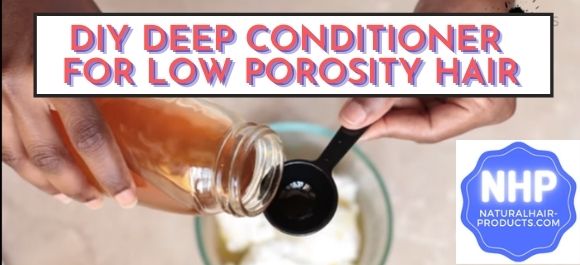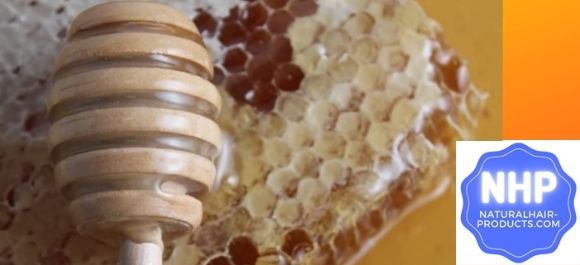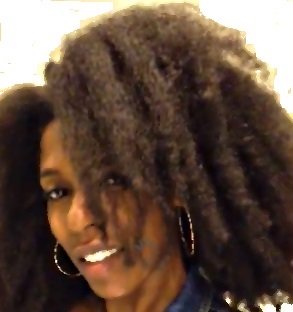Best DIY Deep Conditioner For Low Porosity Hair Regimen
- NHP
- Type 4C Hair 101
- Hair Porosity
- DIY Deep Conditioner For Low Porosity Hair
You have found THE BEST DIY deep conditioner for low porosity hair regimen that exists! Congrats sis!
You’ll get much more than just a recipe, you’re gonna get the DIY recipes and instructions for how to prep your hair for this bomb DIY deep condish for low-po and Imma give you a homemade leave-in for low porosity hair for AFTER you finish your wash day!
So look...
...I know so many low-po girls are saying “it’s hard for me to find a deep conditioner that doesn't just sit on my hair”.
If that’s you…. I got your answers girly!
At the end of the day, we want our hair to feel soft. We want it to be flexible. We want it to keep from tangling up excessively. We want our coils, curls and waves to be as well-defined as they can be (or as you prefer). If you have straightened hair, you want your straight hair to feel and look smooth and show a brilliant shine, without flyaways.
This ain't always easy for low porosity girls...Whereas our porous-haired high porosity counterparts can get those benefits with nothing but a high-quality creamy deep conditioner, we just get a greasy, weighed-down, limp or tacky-feeling result. Ugghhhh….

The Reason for The Best DIY Deep Conditioner For Low Porosity Hair Regimen
I know a lot of times we focus too much on hair typing like…. “Hey I'm 4A, I’m 4B or I have 4C kinky coily-hair”....In all honesty though, knowing your hair porosity and creating a hair care regimen that is based upon your hair porosity type is what's gonna give you the best-looking results for your low porosity hair.
So, today…
I'm gonna focus on giving you the best DIY deep conditioner for low porosity hair regimen, not just a recipe that you don’t know how to use correctly.
You see:
Low porosity hair is characterized as having really tightly-closed cuticles, so with this DIY treatment regimen you’ll learn how to open those cuticles up just a little bit FIRST!
And then you’ll get my DIY deep conditioner for low porosity hair recipe in order to get moisture into your hair while those cuticles are still open.
After that...
This regimen gives a way to close your cuticles so that after the whole process is done your hair will be feeling super soft, shiny and overall healthy. So let’s get into the 1st phase of DIY deep conditioner for low porosity hair regimen. [RELATED ARTICLE: Does low porosity hair really need protein?]
Clarifying: 1st Phase of Regimen DIY Deep Conditioner For Low Porosity Hair
Even the best DIY deep conditioner for low porosity hair can seem like a dud if you fail to remove product build up and gunk first.
So unless your hair is already squeaky clean, you must clarify. I will give you a great DIY recipe and you can also use a premium brand clarifying shampoo.
For all of the low porosity hair DIY recipes below, you’ll be covered as long as you have these six staple ingredients:
- Extra virgin olive oil
- Apple cider vinegar
- Baking soda
- Bentonite clay
- Raw honey
- Jojoba oil
You'll be able to make all of the DIY deep conditioners, clarifying rinses, as well as low porosity hair masks with them. The only thing that these ingredients won’t cover is the special leave-in conditioner recipe at the end of this tutorial.
Clarifying Clay Hair Mask For Low Porosity RECIPE
Before going in and making this amazing clay low porosity hair mask, you should know that when bentonite clay is mixed with any liquid it creates an electric charge and that electric charge is responsible for drawing out toxins, build up and other impurities in your hair.
Because of this, you do not want to use metal utensils to mix this. Instead, use ceramic, plastic, or wooden utensils only. You can mix the clay with just enough water and/or apple cider vinegar to make a nice paste consistency to mask your hair and clarify.
Clay Clarifying Paste Ingredients:
- 3 Tbsp Bentonite Clay
- 2 Tbsp (to start) Water and/or ACV
Continue mixing in small amounts of water and/or ACV until you are satisfied with the paste consistency.
Bentonite Clay Benefits for Your Hair:
- It clarifies hair by removing build up and toxins.
- Mineral rich formula infuses hair with healthy minerals.
- Promotes hair growth.
- Makes hair soft and shiny.
- Controls oil and dandruff issues.
After applying DIY paste mixture to your low porosity hair, you can let it sit under a shower cap for about 30 minutes.
If you don't have 30 minutes to spare, you can just use it as a clay hair rinse and you'll be using this DIY rinse recipe for low porosity clarifying, right here:
Clay Clarifying Rinse Recipe:
- 1 Tbsp Bentonite Clay
- 1 cup ACV
- ½ cup bottled or filtered water
You can use these DIY clarifying mixes after using a high-quality shampoo for low porosity hair and right before you condition your hair.
Baking Soda Clarifying Rinse For Low Porosity RECIPE
Here’s another option for clarifying to make your DIY deep conditioner for low porosity hair more effective.
Baking Soda Clarifying Rinse Ingredients:
- 1/4 to 1/2 cup Baking Soda
- 1 cup water
- Let solution dissolve
When you have low porosity hair, the cuticles on your hair are tightly closed and in order to penetrate and moisturize your hair properly with a DIY deep conditioner you're going to have to do something to open those cuticles up first.
Baking soda will do just that because it has a pH of 9 which is responsible for opening up your cuticles so that you can use this as a step before deep conditioning your hair.
Because of baking soda's ability to open up your hair cuticles it makes it a wonderful clarifying treatment and can be used as a diy shampoo for low porosity hair or just after your shampooing once a month.
[RELATED ARTICLE: Does porous hair hold color?]
Importance of Using Oil Pre-poo / Pre-deep Conditioner for Low Porosity Hair
Sometimes, to TRULY benefit from oils on low porosity hair means you need to know some smart tricks for using it.
Using a hair-penetrating oil on your hair like olive oil, sunflower oil or fractionated coconut oil for several hours before you cleanse your hair can add softness, lubrication and weight to your tresses.
Because you wash after this oil treatment, you won't be left with greasy feeling hair, yet and still, the softness and definition will remain.
Oils do not create product build-up like heavy hair conditioners can (with the exception of plain shea butter, cocoa butter and other solid-at-room-temperature plant butters).
I’m telling you… These oil treatments are ideal for lower porosity hair because even though your hair doesn't soak up tons of oil, it can benefit from it.
And because low porosity hair can be prone to product build-up, oils can be a good option for deep conditioning. When your hair feels on the verge of tangling, use oils that have good lubrication for your pre-wash such as avocado, jojoba, olive or sunflower.
NHP PRO TIP #1: Use a light touch for an oil pre-wash treatment. Just enough oil to add some shine, or maybe a bit more to add some weight and make your hair feel a little "dirty”.
If your hair becomes greasy easily just use the oil on the ends exclusively. Leave on for 2-6 hours. Low porosity hair that isn’t coarse (wide circumference) tends to do better with shorter treatments but slightly coarse and moderatel-to-very coarse hair can take oil longer conditioning treatments.
Use a premium shampoo to cleanse; if you're using a very mild shampoo, you might want to do a second wash with shampoo diluted with water if you used more oil than needed. If you only cowash, be sure to work the hydrating conditioner thoroughly into your hair to remove excess oil.
Honey & Oil DIY Deep Conditioner for Low Porosity Hair
Now we get to the star of the show! This wouldn't be the best DIY deep conditioner for low porosity hair regimen, without a great DIY deep conditioner recipe. So let’s dive in...
Honey & Oil DIY Deep Conditioner Recipe:
- ½ cup Raw Honey
- ¼ cup Jojoba Oil (or another highly penetrative oil like sunflower or fractionated coconut oil…)
- Shower cap
- Let sit for 30 mins
One major key with this DIY deep conditioner for low porosity hair recipe is that you use TRUE organic raw honey that is unprocessed & unpasteurized. It should be thick and you shouldn’t be able to see through the honey bottle to the other side.
Why is this so important?
Because honey that is transparent, runny and has a looser texture has been heat-pasteurized, and during that heat processing a TON of nutrients, antioxidants and antibacterial properties that you want in your low porosity hair have effectively been burned off.
To thoroughly combine your honey and oil mixture you can warm the mixture up on the stove in a saucepan over low heat (just enough to warm the mixture). Don’t worry, it would take high heat to destroy the beneficial properties of these ingredients.
The warming process helps in 2 ways. The warmth makes these ingredients merge together better and will help to open up your cuticles for a deeper penetration of this powerful conditioner when applied while warm.
NHP PRO TIP #2: Lower porosity hair does not take to conditioning products as good as high porosity hair does. So when your hair needs an intense burst of softness, detangling or hydration, always use a deep conditioner, or if you only have normal conditioner add a little oil and whatever else you like added. It also helps to...
Add heat or steam to the treatment, barely warmer than body temperature is all that is necessary.
Leave it on for 5 minutes for hair that gets too soft very quickly, 10-30 minutes for the most intense effect.
Best Cuticle Closer After DIY Deep Conditioner For Low Porosity Hair
The COMPLETE DIY deep conditioner for low porosity hair regimen is the best because I give you more than just a super-effective recipe.
I gave you the way to clarify and open your cuticles BEFORE the deep conditioner even touches your hair with either of the baking soda or bentonite clay recipes, and now I give you the key to closing those hair cuticles and sealing in the hydration and moisture with this easy apple cider vinegar rinse.
Apple Cider Vinegar Rinse Recipe:
- ½ Tbsp Apple Cider Vinegar
- 8 oz filtered water
ACV Rinse Benefits For Your Hair:
- Infuses hair with nutrients like Potassium, Vitamins B & C.
- Closes cuticles
- Restores natural pH of low porosity hair.
- Alpha-hydroxy acid helps exfoliate scalp
- Promotes shine
And that’s officially it! That’s the complete DIY deep conditioner for low porosity hair regimen from pre-conditioning to post-conditioning. But I decided to give you a bonus! Check out this dope homemade leave-in conditioner for low porosity hair...
DIY Homemade Leave-in Conditioner For Low Porosity Hair
Using a moisturizing DIY leave-in conditioner for natural hair is one of the best things you can do for your mane.
This DIY hair recipe is affordable, and you control the ingredients. This is great if you like to avoid harsh chemicals and keep some coins in your purse by buying and blending a few high-quality ingredients yourself. Let’s get to the leave-in conditioner recipe...
DIY Low Porosity Leave-In Conditioner with Aloe Recipe:
- 1 cup distilled aloe vera juice
- 2 tablespoons favorite conditioner
- 2 tablespoons avocado oil
- 1 teaspoon vegetable glycerin (optional)
- 5-15 drops lavender or other pleasant-smelling essential oil
Instructions:
- Pour the distilled aloe vera juice into a clean spray bottle.
- Add your favorite hydrating conditioner or moisture repair conditioner.
- Add the avocado oil.
- Add glycerin and lavender or another favorite essential oil.
- Close the spray bottle and shake vigorously.
- All set! Your leave-in conditioner is ready to use.
This homemade leave-in conditioner for low porosity hair is so beneficial because aloe vera is one of the most hydrating ingredients for hair and you may find that it gives water a boost in effectiveness.
Also, avocado oil is one of the best oils for low porosity hair, and the texture is creamier than olive oil. Sill though, you can use olive oil if you have trouble finding avocado oil.
Keep in mind that this DIY homemade leave-in conditioner for low porosity hair mixture contains no emulsifier. Emulsifiers are usually added to big name-brand products to make the texture consistent.
Because your DIY mixture contains no emulsifier, you’ll need to shake the bottle vigorously each time you use this leave-in conditioner.
Wrap Up: DIY Deep Conditioner For Low Porosity Hair Regimen
So that's it! I told you that this was the best DIY deep conditioner for low porosity hair regimen you’ll find because it focuses on more than a simple DIY hair conditioner recipe.
It’s a step-by-step blueprint to successful moisturization and healthy-looking locks.
This DIY deep conditioner for low porosity hair regimen highlights the importance of opening up your hair cuticles FIRST, in order to allow hydration to get in and then AFTERWARD, this regimen trains you to always seal the cuticle back up so that the moisture doesn't quickly escape.
And because it includes 2 amazingly-effective clarifying recipes for low porosity hair you don't have to struggle with nasty gunk and hair product build up.
I worked hard on this tutorial, I hope you’ll put this DIY deep conditioner for low porosity hair regimen to great use and LOOK FABULOUS!




